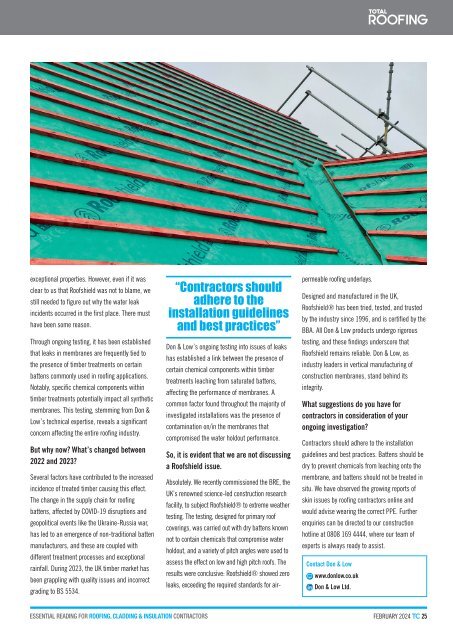February 2024
Create successful ePaper yourself
Turn your PDF publications into a flip-book with our unique Google optimized e-Paper software.
exceptional properties. However, even if it was<br />
clear to us that Roofshield was not to blame, we<br />
still needed to figure out why the water leak<br />
incidents occurred in the first place. There must<br />
have been some reason.<br />
Through ongoing testing, it has been established<br />
that leaks in membranes are frequently tied to<br />
the presence of timber treatments on certain<br />
battens commonly used in roofing applications.<br />
Notably, specific chemical components within<br />
timber treatments potentially impact all synthetic<br />
membranes. This testing, stemming from Don &<br />
Low’s technical expertise, reveals a significant<br />
concern affecting the entire roofing industry.<br />
But why now? What’s changed between<br />
2022 and 2023?<br />
Several factors have contributed to the increased<br />
incidence of treated timber causing this effect.<br />
The change in the supply chain for roofing<br />
battens, affected by COVID-19 disruptions and<br />
geopolitical events like the Ukraine-Russia war,<br />
has led to an emergence of non-traditional batten<br />
manufacturers, and these are coupled with<br />
different treatment processes and exceptional<br />
rainfall. During 2023, the UK timber market has<br />
been grappling with quality issues and incorrect<br />
grading to BS 5534.<br />
“Contractors should<br />
adhere to the<br />
installation guidelines<br />
and best practices”<br />
Don & Low’s ongoing testing into issues of leaks<br />
has established a link between the presence of<br />
certain chemical components within timber<br />
treatments leaching from saturated battens,<br />
affecting the performance of membranes. A<br />
common factor found throughout the majority of<br />
investigated installations was the presence of<br />
contamination on/in the membranes that<br />
compromised the water holdout performance.<br />
So, it is evident that we are not discussing<br />
a Roofshield issue.<br />
Absolutely. We recently commissioned the BRE, the<br />
UK’s renowned science-led construction research<br />
facility, to subject Roofshield® to extreme weather<br />
testing. The testing, designed for primary roof<br />
coverings, was carried out with dry battens known<br />
not to contain chemicals that compromise water<br />
holdout, and a variety of pitch angles were used to<br />
assess the effect on low and high pitch roofs. The<br />
results were conclusive: Roofshield® showed zero<br />
leaks, exceeding the required standards for airpermeable<br />
roofing underlays.<br />
Designed and manufactured in the UK,<br />
Roofshield® has been tried, tested, and trusted<br />
by the industry since 1996, and is certified by the<br />
BBA. All Don & Low products undergo rigorous<br />
testing, and these findings underscore that<br />
Roofshield remains reliable. Don & Low, as<br />
industry leaders in vertical manufacturing of<br />
construction membranes, stand behind its<br />
integrity.<br />
What suggestions do you have for<br />
contractors in consideration of your<br />
ongoing investigation?<br />
Contractors should adhere to the installation<br />
guidelines and best practices. Battens should be<br />
dry to prevent chemicals from leaching onto the<br />
membrane, and battens should not be treated in<br />
situ. We have observed the growing reports of<br />
skin issues by roofing contractors online and<br />
would advise wearing the correct PPE. Further<br />
enquiries can be directed to our construction<br />
hotline at 0808 169 4444, where our team of<br />
experts is always ready to assist.<br />
Contact Don & Low<br />
www.donlow.co.uk<br />
Don & Low Ltd.<br />
FEBRUARY <strong>2024</strong> TC 25
















